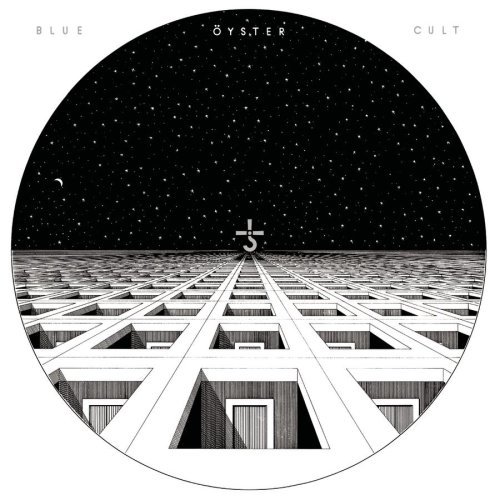Your reaction to this image might reveal many things about yourself and your attitude toward, and awareness of, a certain sort of music.
Quick: what is Blue Öyster Cult’s most famous song?
(Hint: it’s the one with the cowbell.)
Okay: what is Blue Öyster Cult’s second most famous song?
(Yes, the one about the Japanese movie icon.)
Next: what is Blue Öyster Cult’s third most famous song?
(If you were able to listen to the radio circa 1981, or if you still listen to certain radio stations in 2011, you know it. Thirty years, baby: that’s serious staying power and, when you stop and listen, it’s not the least bit surprising. Typically great guitar, excellent vocals and a short-lived adaptability, giving the band’s sound a sensibility somewhat compatible with that early-’80s moment before synthesizers and MTV held sway for the remainder of the decade. It happens to include one of the great lines –and deliveries– of that period, or any period: “Time to play B-sides”. There is something extremely rock and roll, on obvious and subtle levels, there. As it happened, all of us would have plenty of time to play B-sides as music started sounding better the older it got.)
Did you know Blue Öyster Cult had several members share lead vocal duties? Kind of like The Beatles, except few people realize it (and/or care). Of note, however, is the curious fact that lead guitarist Buck Dharma sings all three of these, their most popular, songs. Curiouser fact: as silly a stage name as Buck Dharma might be, it’s an improvement on Donald Roeser. You simply can’t have a lead guitarist named Donald.
Did you know Blue Öyster cult were an American band (from Long Island, no less!)? I didn’t. I always figured they were not only from the UK, but quite possibly a more eastern-European country. Maybe it was because of their semi-epic proclivities (and/or pretensions), and their subject matter, which did not square with so much of the ’70s cock-rock American heavy-metal light sound (think Kiss or Aerosmith or even Van Halen).
Did you know Blue Öyster Cult collaborated with a then mostly-unknown Patti Smith? I didn’t. Sure enough, her association with the band (and their encouragement) led her to consider making her own music, and the rest is most definitely History.
Did you know that the enigmatic symbol (above) has appeared on every one of Blue Öyster Cult’s albums? Did you know what it represents? I didn’t. Over the years I’ve heard everything from a symbol of evil (or Evil, the always unspecified type; the sort associated with idiots who spun records backward to get the hidden –and obviously evil– messages), to an upside-down question mark surrounded by three exclamation points (cool!). Apparently, it is in fact the symbol for the Greek God Kronos, but it also (close enough to being) the symbol for Lead, e.g. the heaviest of metals. Get it?
Did you know Blue Öyster Cult was the first band to use the now near-obligatory umlaut?
So what are Blue Öyster Cult, aside from a band less celebrated than perhaps is warranted? I would venture to opine they are of the progressive rock era, but not necessarily a prog-rock band: even at their most eccentric they were writing short-ish pop-ish songs that at least aspired to being played on the radio. And there is nothing wrong with that. The converse, that a “pure” prog-rock band eschewed commercial consideration is not axiomatic; however, when your band makes songs that last more than five minutes, and sometimes ten, and occasionally occupy an entire album side, heavy rotation in the Billboard Top 100 is not going to be in the cards. Blue Öyster Cult seems to exist peacefully in between the rusty spaces of prog-rock and Heavy Metal, with touches of glam-rock and arena-rock to round out the edges.
However: Blue Öyster Cult, perhaps because of the times or more likely because of their personalities, were not reluctant to throw down with a combination of the esoteric and ambitious that could satisfy fans of both Peter Gabriel-era Genesis and Jethro Tull.
Consider a song like “Nosferatu” (from ’77, which means they were two years ahead of the great Werner Herzog and his risky but brilliant vision to have the inimitable Klaus Kinski reprise the role made famous by the inimitable (!) Max Schreck). Perhaps this is why I tended to think these cats were European (German, even!): who made songs like this? Bands in the ’70s, that’s who. And this one speaks saliently to the better angels (or demons) of the prog-rock ethos, taking liberty with literary tropes and wearing those artsy-fartsy influences proudly on their leather sleeves. Of course, there is an extremely fine line between ambition and self-parody, as Spinal Tap (umlaut!) illustrates. As always, the music has to account for itself without excess elaboration or even explanation. Decide for yourself if it is worthy (hint: it is).
And while we’re on the subject of the best songs you may never have heard, how about “The Vigil”? I dare you to be unmoved by that guitar work, and the multi-tracked vocals soar (yes, soar!) in the way the best ’70s songs did. Don’t blame the drugs, the clothes or the groupies; this was all about inspiration and the reason we return to this music –even if some of us have never listened to it– is because there is definitely a soul sorely lacking from entirely too much of the safe, pre-packaged, status seeking, sugar-free swill that pollutes so many minds of this wet-behind-the-ears iPod generation.
To be continued. Be afraid.


